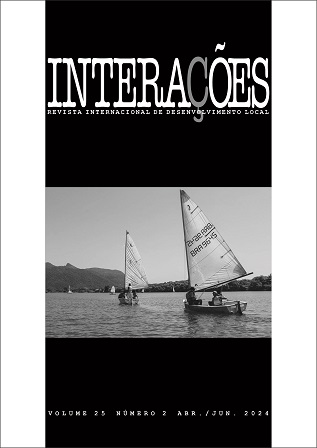Methodological contributions for the studies on geographical indications: valuing territorial resources according to the action keys of the EPAGRI Guide, 2020, and the FAO Guide Uniendo Personas, Territorios y Productos para Fomentar la Calidad Vinculada al Origen y las Indicaciones Geográficas Sostenibles, 2011
Keywords:
Specification Book, FAO Virtuous Circle, EPAGRIAbstract
The present work aims to bring and trace the main points contained in the EPAGRI Methodological booklet, from the Agricultural Research and Rural Extension Company of Santa Catarina, Brazil, as a reference in the field of geographical indications, in a look relatively to the FAO virtuous circle proposal, from the UN Food and Agriculture Agency. Thus, the study consisted of a systematic bibliography review, with a descriptive character and a quali-quanti approach, with an empirical nature and with the use of interdisciplinary and epistemological studies and secondary documents around the theme, as well as articles and dissertations, books and digital materials. The partial results found in these methodological studies indicate that the local territorial valorization and development are the result of local, tacit and implicit knowledge, which were built and acquired over the years in a given region and community, consisting of true goods and intangible assets and capable of being exploited via ecotourism, for example, primarily considering the FAO method of the virtuous circle that allows the articulation of different territorial, local, cultural, social, economic, political and legal factors in favor of the development of a certain location.
References
BENKO, G.; PECQUEUR, B. Os recursos de territórios e os territórios de recursos. Geosul, Florianópolis, v. 16, n. 32, p. 31–50, jul./dez. 2001.
CALDAS, A. S.; CERQUEIRA, P. S.; PERIN, T. F. Mais além dos arranjos produtivos locais: as indicações geográficas protegidas como unidades de desenvolvimento local. RDE. Revista de Desenvolvimento Econômico, Salvador, n. 11, p. 5–15, 2005.
HAESBAERT, R. Territórios e multiterritorialidade: um debate. Revista GEOgraphia, Rio de Janeiro, Ano IX, n. 17, p. 19–45, 2007.
JANIN, C.; PERRON, L. Valorizar os recursos territoriais: chaves para a ação – guia metodológico. Tradução de Domitila Madureira. Florianópolis, SC: Epagri, 2020. 147 p. (Epagri Documentos, n. 304).
MAIORKI, G. J.; DALLABRIDA, V. R. A Indicação Geográfica de produtos: um estudo sobre sua contribuição econômica no desenvolvimento territorial. In: DALLABRIDA, V. R. (Org.). Indicação Geográfica e Desenvolvimento Territorial: reflexões sobre o tema e potencialidades no Estado de Santa Catarina. 1. ed. São Paulo: Editora LiberArs, 2015. v. 1, p. 41–56.
MELO, J. P. B; COSTA, José da Silva. A problemática e as políticas de desenvolvimento local. In: COSTA, José da Silva. Compêndio de economia regional. Coimbra, Portugal: Associação Portuguesa para o Desenvolvimento Regional [APDR], 2002. p. 515–33.
PECQUEUR, B. Le développement local: mode ou modèle. 2. ed. Paris: Syros-la Découverte, 2000.
RIBEIRO. Território e políticas de desenvolvimento territorial no Brasil. Revista Para onde?, Porto Alegre, v. 11, n. 1, p. 75–82, 2019. O conteúdo está disponível em https://seer.ufrgs.br/paraonde/article/view/91719/52664. Acesso em: 15 nov. 2022.
SANTOS, M. O retorno do território. OSAL, Ano VI, n. 16, p. 251–61, jan./abr., 2005.
Downloads
Published
How to Cite
Issue
Section
License
Copyright (c) 2023 GIOVANNA, ALCIDES DOS SANTOS CALDAS, BETINA AMERICANO COSTA PINTO

This work is licensed under a Creative Commons Attribution 4.0 International License.
Direitos Autorais para artigos publicados nesta revista são do autor, com direitos de primeira publicação para a revista. Em virtude de aparecerem nesta revista de acesso público, os artigos são de uso gratuito, com atribuições próprias, em aplicações educacionais e não-comerciais.


